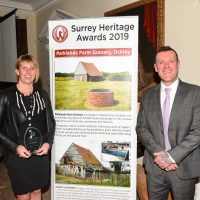


Surrey’s best heritage conservation projects were on show at a major event held at West Horsley Place, one of Surrey’s most significant historic buildings.
The winners of the Surrey Heritage Awards 2019 were announced by Mr Matthew Slocombe, Director of the Society for the Protection of Ancient Buildings (SPAB), and the trophy for the overall winner was presented by Mr Michael More-Molyneux, Lord-Lieutenant of Surrey and the Patron of the Surrey Historic Buildings Trust.
Scooping the top prize was the Parklands Farm Granary in Ockley, an unusual agricultural building dating back over three hundred years which had been at risk of collapsing when new owners took over and began a major programme of repairs and conservation.
All of the buildings on this year’s Awards shortlist are between three hundred and five hundred years old, several of them timber-framed buildings from the fifteenth and sixteenth centuries. “Highly Commended” by the award judging panel were Sunt Farmhouse in Oxted and the Lythe Hill Hotel in Chiddingfold. Runners-up were Manor Cottage in Shere, Yew Tree Cottage in Wrecclesham and Oatlands Park in Weybridge.
The biennial Surrey Heritage Awards were established by the Surrey Historic Buildings Trust to recognise “Best Practice” in historic building conservation in Surrey. Surrey Life Magazine is the Trust’s official Media Partner for these awards.
This year’s award ceremony was held at West Horsley Place by kind permission of Mr Bamber Gascoigne and the Mary Roxburghe Trust. This imposing building in West Horsley, substantial parts of which are medieval, is currently undergoing a major conservation programme of its own.
Winner – Parklands Farm Granary, Ockley
Parklands Farm Granary is a Grade II listed late seventeenth or early eighteenth-century granary, located over a cart shed. Much of the granary’s original fabric had been retained, including its corn bins, and its modest scale and relationship with the cart shed makes it an unusual piece of surviving Surrey vernacular architecture.
The granary was in a particularly poor condition following years of neglect. The main structural posts in the building had moved, resulting in one corner subsiding and pulling the butt rafters out of the purlin. The roof was also in a poor condition causing significant rot throughout the structure.
The work carried out included stripping the roof and jacking the building up to re-engage the rafter-to-purlin joints and allow the leaning timbers to be set near upright. The tiles were reinstated and the internal plasterwork repaired with traditional lath and plaster to the affected areas. The ground floor of the building was part enclosed by walls made from traditional plank bark-edge offcuts.
In their comments, the judging panel noted that “the granary was on the point of collapse when the owners bought the property. Although it had minimal economic value, the owners appreciated it for its historic character, and the contribution it makes to the setting of the listed farmhouse. The contractor was able to stabilise the granary without dismantling it and has done an excellent job of carrying out sympathetic repairs using traditional materials and techniques.”
Highly Commended – Sunt Farmhouse, Oxted
Sunt Farmhouse is a late sixteenth-century two-storey timber-framed house. It has large back-to-back hearths on each floor built with earth mortar rather than lime. Other unusual features include historic sliding shutters and Yorkshire sliding sash windows and a solid tread staircase.
The conservation project aimed to enhance the significance of the house by removing the modern uPVC windows, which had been added to an extension to the property in the late twentieth century. Repairs were also carried out to the unusual Yorkshire sash windows as part of the project. Black paint, which is not a historic feature of timber-framed buildings, was removed from many of the timbers inside the house. The most notable work was the reinstatement of the fireplaces to their original designs, using historic methods.
The judges said they were “impressed with the use of sympathetic craftsmanship, traditional materials and reversing unwelcome works previously undertaken”, adding: “Modern services have been introduced to the building but the carefully preserved elements show the building has retained its historic character and the patina of age.”
Highly Commended – Lythe Hill Hotel, Chiddingfold
Lythe Hill Hotel is a Grade II* listed building which comprises a fifteenth-century Wealden hall-house with a late sixteenth-century wing. This wing has notable decorative timber framing, which is a particularly rare feature in Surrey.
Despite its outward appearance, much of the decorative framing was in a very poor condition having suffered from rot or beetle infestation. Other areas had been replaced by a painted cement render which was causing significant structural issues leaving part of the hotel unusable.
To ensure works were carried out with minimal intervention, drawings were produced showing which timbers needed to be repaired or, in many cases, reinstated. In particular, most of the gable needed to be rebuilt. Much of the lathe and plaster infill had been replaced inappropriately in brick and concrete in the past. New panels were constructed with wood, wool and lime render to allow the building to breathe.
Judges noted the scale of the project and commended efforts “to retain as much decorative timber as possible. The detailed records kept of the project were also remarked on as this would help inform any future repair projects.”
Runner-up – Manor Cottage, Shere
Manor Cottage is a fifteenth to sixteenth century timber-framed house in the centre of Shere, with a modern extension to the rear. The project sought to repair the building using traditional materials and techniques. Manor Cottage was in a poor condition as a cement and sand render on the property was causing rot by not allowing historic materials to breathe. The rising level of the pavement had also caused problems with damp on the front wall.
As part of the project, the owner carried out much of the work himself, taking the opportunity to learn about traditional techniques. This included removing the harmful render, repointing the existing brickwork and carrying out repairs to the timber framing. A French drain was installed outside the front of the property and a drop kerb reinstated to improve drainage. As part of the work the early twentieth-century extension was replaced in oak and was designed to complement the existing building and provide a modern kitchen.
The judging panel felt this was “a well-conceived and executed conservation project led by a hands-on owner who was keen to understand and learn how to use traditional materials. In the long term the works should improve the condition of the building by preventing damp and rot.”
Runner-up – Old Yew Tree Cottage, Wrecclesham
Old Yew Tree Cottage is a sixteenth-century smoke bay house, one end of which was rebuilt as a chimney parlour wing. The oldest part of the house has been dated to 1551.
This building had little work done in the last 100 years and therefore represented a rare opportunity for the Farnham Trust to take it on as a project to learn more about its history. As part of the work, the Trust were able to identify the location of a smoke bay at the end of the building, a historic window and the original first floor ceiling.
Where additional strength was required in the timber frame, new timbers were added alongside the old so that the original fabric could be retained. Where rebuilding of brickwork was necessary, lime mortar was used alongside lime plaster, finished with clay paint to ensure the historic fabric remained breathable. Historic elm floorboards were also retained as part of the project and carefully re-laid where rooms required more structural support.
The judges noted that in addition to refurbishing a vulnerable listed building and retaining much historic fabric, significant recording work was undertaken during the project and this has been deposited in a public archive.
Runner-up – Oatlands Park Gates, Weybridge
Oatlands Park Gates are set at the edge of the Oatlands Hotel, formerly the site of Oatlands House. Research conducted as a result of the repairs established that the gates were based on a design by notable landscape gardener William Kent and constructed during the mid to late eighteenth century.
Following a piece of masonry coming loose, it was established that rusting iron cramps in the masonry were causing damage and had to be removed. Steam cleaning was carried out to identify further repairs and ensure that new stone inserts would blend with the existing masonry. Rusting iron cramps were replaced with stainless steel and loose masonry pinned and resin-bonded where necessary. To ensure that best conservation practice was followed, historic repairs were retained and paint analysis carried out on the railings. A total of 150 repairs were carried out as part of the project.
Judges were “impressed by the retention of historic repairs and paint analysis, the latter of which revealed the origins of the gates. The photographic record of the gates was also commendable and will help inform periodic repairs in the future.”